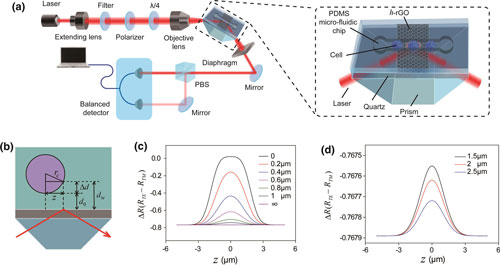| Posted: May 15, 2014 | |
Graphene-based optical sensor detects single cancer cells |
|
| (Nanowerk Spotlight) The nanotechnology-enabled detection of a change in individual cells, for instance cell surface charge, presents a new alternative and complementary method for disease detection and diagnosis. Since diseased cells, such as cancer cells, frequently carry information that distinguishes them from normal cells, accurate probing of these cells is critical for early detection of a disease. | |
| In a previous Nanowerk Spotlight ("Catch and release sensing of single malaria-infected red blood cells") we reported on sensitive flow sensing of a single cell based on graphene field-effect transistors. In this work, researchers demonstrated that an array of graphene transistors integrated with microfluidics can be employed to detect the change to the cell surface charge of a cell infected with a virus. | |
| "Relative to the temporal and spatial resolutions of optical sensing, the temporal and spatial resolutions of transistor-based graphene flow sensing of a single cell are greatly restricted," Zhi-Bo Liu, an associate professor at the School of Physics, Nankai University, tells Nanowerk. | |
| He notes that the main challenge in optical flow sensing of single cells is to improve the sensitivity to achieve the purpose of fast response, non-contact, low-diseased cells proportion sensing in a small volume sample size. | |
| In a new paper in the May 5, 2014 online edition of Nano Letters ("Ultrasensitive Flow Sensing of a Single Cell Using Graphene-Based Optical Sensors"), Liu and collaborators report the design of a graphene-based optical refractive index sensor. | |
 |
|
| Experimental setup and theoretical simulation. (a) Flow-sensing system for a single-cell setup. The inset provides the schematic of the graphene-based optical single-cell sensor (GSOCS), which is a PDMS microfluidic chip/h-rGO/quartz sandwich structure on the prism. (b) Theoretical model of the flow sensing of a single cell. (c,d) Theoretical simulation results for a single PS microsphere that rolls across the detection window of the GSOCS with increasing d0. (Reprinted with permission from American Chemical Society) (click image to enlarge) | |
| "We obtained our ultrasensitive graphene optical sensor by controlling the thickness of high-temperature reduced graphene oxide," explains Liu. "With this method, the limits of sensitivity and resolution for refractive index sensing are increased to 4.3 × 107 mV/ RIU and 1.7 × 10-8, respectively. The resolution is the highest values reported for refractive index sensors." | |
| The researchers found that, in order to achieve the most sensitive sensing, ∼8 nm thick high-temperature reduced graphene oxide (h-rGO) is the optimal choice as a sensing layer compared with other types of graphene. | |
| "The refractive indices of cancer cells are significantly larger than those of normal cells," explains Liu. "In our experiments, we showed that our sensor in a microfluidic channel detects lymphocytes and cancer cells extracted from the blood. We mixed a low percentage (1%) of cancer cells with normal lymphocytes and even at this very low proportion detected the signal changes in voltage with the sensor." | |
| He adds that this graphene-based optical single-cell sensor can provide comprehensive information regarding each cell signal, which is extremely important for research on the cell submicroscopic structure. | |
| There are still a few challenges to overcome before this type of sensor could be used in a clinical environment. Currently, this flow sensing method can only study blood cells that are suspended. Furthermore, the types of cells that can be analyzed is still very limited. | |
| "In the future, we hope to improve the measurement mechanisms and methods to achieve the purpose of measuring various types of cells," says Liu. "Also, the sensor's ultrahigh resolution and sensitivity to refractive index measurements can be extended to other areas, such as drug discovery, environmental monitoring, and gas- and liquid-phase chemical sensing." | |
 By
Michael
Berger
– Michael is author of three books by the Royal Society of Chemistry:
Nano-Society: Pushing the Boundaries of Technology,
Nanotechnology: The Future is Tiny, and
Nanoengineering: The Skills and Tools Making Technology Invisible
Copyright ©
Nanowerk LLC
By
Michael
Berger
– Michael is author of three books by the Royal Society of Chemistry:
Nano-Society: Pushing the Boundaries of Technology,
Nanotechnology: The Future is Tiny, and
Nanoengineering: The Skills and Tools Making Technology Invisible
Copyright ©
Nanowerk LLC
|
|
|
Become a Spotlight guest author! Join our large and growing group of guest contributors. Have you just published a scientific paper or have other exciting developments to share with the nanotechnology community? Here is how to publish on nanowerk.com. |
|
